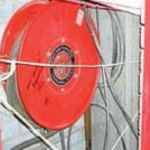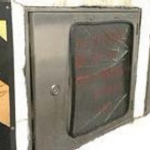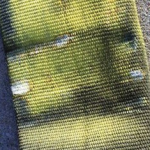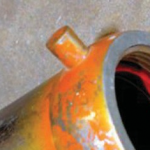Fire hoses allow fire-fighters to work closer to the fire without endangering their engines and to increase the accuracy of water placement.
|
Defects
|
Probable causes for the defect
|
Design for Maintainability (DfM) Guidelines
|
Damaged hose–cut kink, leak, missing part, abrasion
 Haphazard winding |
- Misuse – washing floors or vehicles etc, mishandling.
- Wear and tear with time. Accelerated aging if of poor make.
- Improper winding due to careless handling. Velcro strap damaged.
|
Design
-
Ensure that the fire hose reel is suitable for the particular use of the facility in question, and that it complies with the related standards (BS EN 694:2014, BS EN 1947:2014).
-
Comply with the technical quality acceptance for fire hoses as per BS 6391:2009.
-
Fulfill cabinet specification (size and mounting) as per standard guidelines. Follow the distribution and number of fire hose reel cabinets as per SS 575:2012. (See also BS 9990:2015, NFPA 14:2016).
-
Ensure that access to or visibility of fire hose is not obstructed.
-
Fire hose cabinet should be made of maintenance-free fire- proof material.
-
The location should allow for 180° opening of cabinet door. The wall mounted type is only allowed in riser main shaft.
Construction
-
Protect hose reels from mechanical damages. The reel should be mounted overhead, but the nozzle retainer, hose guide and inlet valve must be kept at 900mm above finished floor level (BS 9990:2015, SS 575:2012, NFPA 14:2016).
-
During commissioning, the hose should be flushed out to remove harmful matter.
-
Conduct flush out test to remove any kink or knot and to ensure that all valves and nozzles are operational.
-
Ensure that reel brackets are firmly fixed, so that the hose can be used properly.
Maintenance
- Perform proper housekeeping and avoid mishandling.
- Once a month, check for corrosion/leakage (of drum), and ensure that hose, nozzle, stopcock, hinges, break glass device and cabinet are in acceptable working condition. Lubricate as required.
- Conduct monthly water flow pressure test and annual hydrostatic test (BS EN 1402:2009) to check for defects or leaks, especially if the hose has been exposed to chemical or severe stress.
- During the test, the hose is completely run out and subjected to operational pressure.
- After the test, it should be dried and properly secured with a Velcro strap.
- Ensure that fire hose is stored in a cool, dry place (ISO 2230:2002).
|
Damaged cabinet
 Damaged hose reel cabinet |
- Located in a place vulnerable to mechanical damage.
- Glazing broken or glass break device missing due to vandalism.
|
| Cabinet Difficult to open |
- Hinges not lubricated, corroded from poor make especially if in extreme damp location.
|
Damaged nozzle
 Damaged hose reel  Damaged fire hose coupling |
- Mishandling, poor maintenance. E.g. dislodged from stem or not connected to hose rack nipple or valve.
- Jammed, obstructed if not cleaned properly or flushed out.
|
References
[1]
Normative References/Standards Referred to for Air Handling Unit and Fan Coil Unit



